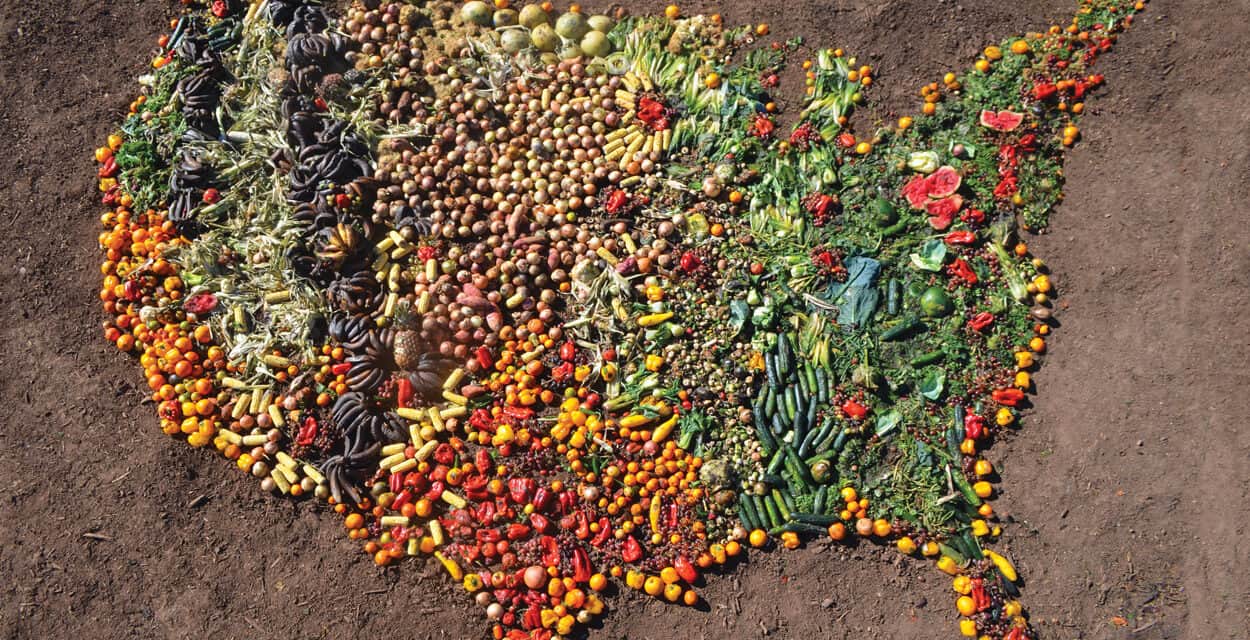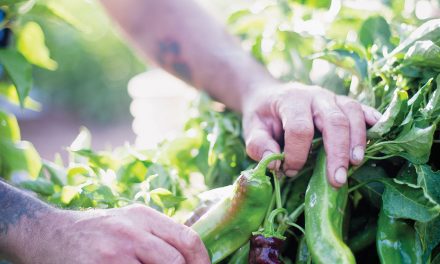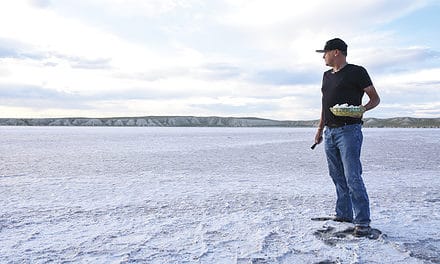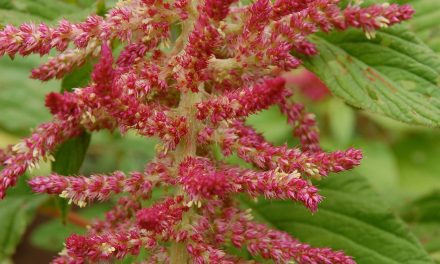by Nancy Zastudil

Food Waste USA installation at Polk’s Folly Farm. Food Waste Project installation artists include Billy Joe Miller, Sarah Wentzel-Fisher, Zach Withers, Rosie Hutchinson, Henry Hutchinson, Merle Hutchinson, Aldo Stearnes, Max Richardson, Rachel Nelson, Graham Ansell Coy, and Thaïs Ferrandis Ansell Coy. Photo by Billy Joe Miller.
In her book An Everlasting Meal: Cooking with Economy and Grace, Chef Tamar Adler writes, “The amount of food you have left from a meal is always the perfect amount for something.” The lesson is simple: endings are beginnings, not to be wasted.
Interdisciplinary artist Billy Joe Miller believes in this cycle of regeneration. He embraces a site-responsive approach to create sculptures, installations, and public art that rouse our senses through engagement with the natural world. By incorporating organic materials and architectural elements, his artworks shape how we engage with a sense of place and feelings of belonging.
Just a few miles from Miller’s house and art studio in Cedar Crest is Polk’s Folly Farm, where an arguably magical natural process of growth and decay—inextricable endings and beginnings—takes place every day. He has been spending time there as an artist-in-residence of sorts, using sculpture and photography to consider our roles in the food waste system and inviting others to do the same.
Zach Withers and his brother Ethan, who own and operate the farm, repurpose millions of pounds of food waste annually from local food rescue organizations like Roadrunner Food Bank of New Mexico and Food is Free Albuquerque (FIFABQ). They use the mountains of expired produce and baked goods to supplement the diets of their heritage-breed hogs and for compost on the farm and beyond.
At Polk’s Folly, the process of making compost and feeding animals is intertwined. Food waste is fed to the pigs on top of a layer of wood mulch inside the pens; what the pigs don’t eat, they stomp into the mulch. The process creates a deep bed of organic material that is harvested, blended, aerated, and put out into windrows to compost.
“The compost is used to regenerate pastures on our farm and amend the soils in our small garden and orchard,” explains Withers. “It is also being used in various field trials throughout the state to test the effects of various rates of compost application on arid rangelands, which is part of the Carbon Ranching Initiative being spearheaded by the Quivira Coalition. We also supply compost to a few local farms that we source produce from for our farm stand.”
In the United States, 31 percent of food loss occurs at the retail and consumer levels. In 2012, global food loss and waste generated approximately 8 percent of total anthropogenic greenhouse gas (GHG) emissions, namely methane. Taking into account land use, production, processing, distribution, consumption, and waste, one-third of GHG comes from the food system as a whole.
Those numbers seized Miller’s attention, initially after an Instagram post by Polk’s Folly to that effect. He recognized that while individuals might not be able to directly impact the production models that create this food waste, the issue of reducing the amount of food that ends up in landfills is one people can address by composting at home, in their backyards, and with their neighbors. Seeing this potential, he was compelled to use his skills as an artist, his interest in public engagement, and his experiences in community-driven projects to help people understand their agency within the food waste system. He began brainstorming with Zach Withers and Sarah Wentzel-Fisher (executive director of the Quivira Coalition, who also lives on the farm), and the trio embarked on an ongoing collaborative investigation of food waste through art making.
But what exactly is food waste? What does it look like? The United States Department of Agriculture defines food loss and waste as “the edible amount of food, postharvest, that is available for human consumption but is not consumed for any reason.” Miller sees the repurposed food waste at Polk’s Folly as an opulent and profound opportunity to make challenges and solutions visible, even flavorful, through art and direct engagement.
“Food waste is a shining example of how we feel totally disempowered in our food systems,” says Wentzel-Fisher. “So how can we feel a sense of ownership and participation and agency in our food systems? Maybe it’s having a garden, maybe it’s going to the farmers market, maybe it’s thinking about food waste and producing compost. Maybe it’s also getting involved in the policy surrounding food. Maybe it’s finding other ways to support farmers. And I think that’s what we need in this moment—for people to be creative and lean in with their neighbors.”

Top left, clockwise: Food Waste Wreath; Rachel Nelson; Zach Withers, Aldo Stearnes, and Sarah Wentzel-Fisher. Photos by Billy Joe Miller. Bottom left: Billy Joe Miller working on Food Waste Tapestry installation, photo by Sarah Wentzel-Fisher.
Miller has taken small groups of artists and art enthusiasts to the farm and says, “Each time, we’re moved by the mountain of food and a little shocked with how much is thrown out. One of my friends called it a strange kind of cornucopia. So much of the food is still good that we’ve eaten from the pile.”
During the visits to Polk’s Folly, Miller and his collaborators create spontaneous artworks on the land and in the soil, using the food waste as their artistic materials. They pull pieces from the massive piles of expired food to compose sculptural quilt-like color gradients, full of varying sizes and textures. He typically makes photographs of these arrangements, which he plans to share publicly as a way to bring other people into the conversation about how each of us can directly address food waste.
“I’m trying to draw awareness to our relationship with food waste and its social and environmental impacts, including consumption and wasted resources,” he says. “I can see many meaningful effects of following our food waste back to the ground. When we compost, we have to take food waste outside and interact with and change the soil, or maybe we take it to a local garden and connect with our neighbors. Either way, we become aware of our waste and get involved with the cycle.”
“It’s fun to hear Billy Joe articulate the entire origin of the project. Hearing about those experiences and his different perspective, after being up to my eyeballs in food waste for six years, is really refreshing,” says Withers.
Artists have long been interested in food, using it as both medium and subject matter, often in service of a greater good. California is ripe, so to speak, with these kinds of projects. For example, Amy Franceschini, based in the Bay Area, founded Futurefarmers, an international group of artists, anthropologists, farmers, and architects who work together to propose alternatives to the social, political, and environmental organization of space. David Allen Burns, Austin Young, and Matias Viegener founded the Los Angeles–based collective Fallen Fruit, creating maps of the fruit trees growing on or over public property. Ted Purves and Susanne Cockrell created Temescal Amity Works in the Temescal neighborhood of Oakland, where they gleaned fruit from lemon trees, interested in how a specific community builds relationships through personal and casual economies.
Closer to home, the Land Arts of the American West program at the University of New Mexico examines foodsheds and watersheds during semester-long field excursions. And SITE Santa Fe hosts SPREAD, contextualizing a meal as a micro-funding opportunity through which artists can receive project support.
Many of Miller’s other artworks address moments, even thresholds, of transition, informed by his many years working as a hospice nursing assistant. So perhaps most poetically aligned with Miller’s ongoing project at Polk’s Folly is the work of artist Félix González-Torres, who in the early nineties created a series of installations of candy—piles of individually wrapped pieces free for the taking and perpetually replaceable. The shrinking and swelling mounds speak to loss, grief, and the passing of time while simultaneously showing the impact of personal actions within a larger system.
This muse is nothing new. In the seventeenth century, early Flemish still-life paintings set the stage for much of how food is addressed in Western art, depicting objects and food as allegories of life, death, and nature, as well as class hierarchies and material wealth.
How we view and treat food today remains an indicator of local and national values. According to ReFED, 35 percent of all food in the United States went unsold or uneaten in 2019. And yet at the same time, Feeding America reports that each year 15.8 percent (324,000 people) in New Mexico are at risk of hunger—that’s one in seven people, and one in five children.
To help address this, Roadrunner Food Bank, the largest nonprofit in the state dedicated to solving food insecurity, provides food to hundreds of affiliated member partners around New Mexico, including food pantries, soup kitchens, shelters, and regional food banks. From their two Albuquerque distribution points alone (EXPO New Mexico and AMC CLASSIC theater in the South Valley), Roadrunner has been directly serving anywhere from five hundred to nine hundred households every week during the pandemic.
“There’s nuance to managing and organizing and running a food rescue program,” says Joseph Phy, Roadrunner’s chief operating officer. “It’s all about connecting the dots and having enough education for folks no matter where they’re at, whether they’re in agribusiness or wholesaling or food rescue. It’s having that education about what hunger looks like, not only in our state, but in our country, and having continued conversations and continued initiatives and improvement programs within those companies.”
In 2021, Roadrunner distributed approximately 58.9 million pounds of food, of which an estimated 18.6 million pounds was food rescue. Phy is quick to point out that volunteers are vital to the process of food rescue and waste diversion. Whether sorting, boxing, or distributing, Roadrunner’s volunteer force equates to thirty-five additional full-time staff. Still, the need for more volunteers remains urgent as the pandemic surges on.
Polk’s Folly instituted food-rescue efforts about two years into running operations at their pig farm, and nine months into a bad drought, when they realized that their pasture-based production model was not working very well. They decided to try repurposing food waste to feed their animals—a temporary solution that has since become their standard practice.
“I remember when Erin Garrison of Food is Free Albuquerque brought over a little hatchback full of boxes of food—free food to feed the pigs—and I was like, ‘Holy crap,’” says Withers. “Fast-forward four years and we have gone through all sorts of iterations of food rescue and composting.” He also recalls picking up approximately 14,000 pounds of organic waste one day from Roadrunner Food Bank and returning the next for another 8,000. “And that’s just a drop in the bucket,” he says. (In 2020 alone, they picked up 1.3 million pounds of expired produce from Roadrunner.)

Food Waste Cornucopia. Photo by Billy Joe Miller.
Garrison and her business partner, Trista Teeter, started FIFABQ in 2014, when they realized they were buying food from the grocery store when it was abundantly growing, and often going to waste, in their neighborhood. They were seeing firsthand the painful irony of food production, waste, and hunger and were compelled to do something about it. “We put up a Craigslist ad looking for people who had fruit trees that they weren’t harvesting. We received about ten responses, and being the ambitious people that we are, we scheduled all of them,” says Garrison. “We went to the first tree and harvested about two hundred pounds. I’m not great at math, but that was going to be way more than what we needed for our families.”
Since then, FIFABQ has evolved into a local produce-gleaning organization that, as of December 2021, has harvested 61,649 pounds of food from private yards and farms, distributing it to “those forgotten by our current food system,” as they state on their website. In the process, Garrison explains, FIFABQ practices mindful distribution, which honors the food and the people involved and avoids creating additional waste.
“Fresh food is a human right,” she says. “Everybody, everybody, should have access to fresh food.”
Compost, integral to regenerative farming, is another means of putting food waste to beneficial use. ReFED reports that, out of all the food-recycling methods, centralized composting diverts the most waste, adding over two million tons of compost annually to fuel growth in the sustainable farming and environmental remediation markets. Soilutions, located in Albuquerque, is New Mexico’s largest private compost producer. In partnership with more than fifty local commercial businesses, they’ve diverted almost forty-three million pounds of food waste from the landfill and back into replenishing the state’s soil. Partners include The Grove Cafe & Market, where owners Jason and Lauren Greene incorporated composting at the restaurant’s inception. Other participating locals include Farm & Table, La Cumbre, and Humble Coffee, among others.
“We need a lot more education, but I think people are coming around to the idea of composting a lot quicker here in New Mexico,” says Ben Dickerson, Soilutions business development manager. He is quick to mention that Indigenous communities are leading the way back to healthy soils. “We are seeing the effects of climate change; we’re in the midst of a twenty-two-year drought, and we just don’t know that it’s going to end. But over the last five years, the amount of organic and regenerative farmers—small farms—that we’ve seen pop up has increased, maybe five to ten new regenerative farmers every year. That gives me hope. But we still have a long way to go.”
Also committed to the powers of composting is Brad Weikel, owner and founder of Little Green Bucket, Albuquerque’s only curbside residential food-scrap-collection business. Before launching the endeavor, he says, “When I started looking at the math of food waste, it was alarming. And Little Green Bucket seemed like a great way to start to chip away at that locally. . . . One of the real values of our service is that it makes it super easy for people to compost.”
As seen at Polk’s Folly, launching a food-waste, -rescue, or -repurposing program can take an imaginative form while addressing critical challenges. Withers says, “Food waste going to the landfill is a major greenhouse gas emissions issue, but it could be part of the climate crisis solution,” explaining further that compost can reduce methane emissions and build carbon in soil, helping to offset the negative effects of the food system.
The practical and creative food-based work taking place between Miller and Polk’s Folly echoes Chef Adler’s sentiment—the connection between endings and beginnings is one of purpose. For now, Miller will continue his durational artistic process—sculpting, photographing, composing the decomposing material—at the speed of the decay itself. And as he aims to educate and inspire people through the medium of food waste and the act of composting, considering both as change agents within a larger system, he and his collaborators join a host of others in questioning where our food comes from and determining where it goes next.

Nancy Zastudil
Nancy Zastudil is an editor, writer, and curator working toward equitable representation in and access to the arts. She has more than fifteen years of experience in arts administration, regularly edits artist books and exhibition catalogs, and has written for Arts and Culture Texas, Art Lies, Hyperallergic, Southwest Contemporary, and more. Zastudil holds an MA in curatorial practice from California College of the Arts and a BFA in painting and drawing from the Ohio State University.














